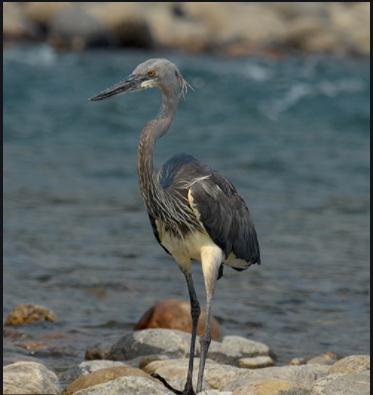- A nocturnal bird found only in the northern part of the state of Andhra Pradesh in peninsular India, the Jerdon’s Courser (Rhinoptilus bitorquatus) is a flagship species for the extremely threatened scrub jungle. Until 1986 when it was rediscovered, it was thought to be extinct. The area where the species was rediscovered was subsequently declared as the Sri Lankamalleswara Wildlife Sanctuary
Habitat: Undisturbed scrub jungle with open areas.
Distribution: Jerdon’s Courser is endemic to Andhra Pradesh. Its presence is attributed in the neighboring areas of the state of Maharashtra as per the records of the 19th Century.
Threats: Illegal poaching and trapping of birds, clearance of scrub jungles for commercial purposes, setting up of new pastureland, cultivation of dry land crops and exotic species of trees along with mining, quarrying and the construction of the Telugu-Ganga Canal.

- Found in five or six specific locations in the state of Assam and Arunachal Pradesh, one or two sites in Bhutan, and very few in Myanmar, the White-bellied Heron (Ardea insignis) is an extremely rare bird. Its populations have remained very low throughout their existence and are inherently rare
Habitat: Inland lakes. Gravel Bars and Sandy Rivers.
Distribution: North Myanmar, Hills of Bangladesh and North Eastern India along with Bhutan.
Threats: Anthropological disturbance which causes degradation of Lowland Forests and Wetlands via exploitation.

- Out of nine species of vultures, the population of three species- White-backed Vulture (Gyps bengalensis), Slender-billed Vulture (Gyps tenuirostris) and Long-billed Vulture (Gyps indicus) has declined by 99%. The Red- headed Vulture (Sarcogyps calvus) has also suffered a rapid decline in the recent past. Vultures keep the environment clean, by scavenging on animal carcasses. The decline in vulture populations has associated disease risks, including increased risk of spread of rabies and anthrax
Habitat: Forests, villages etc.
Distribution: Across India.
Threats: A major threat to vultures is the painkiller diclofenac used by veterinarians to treat cattle. When vultures consume these carcasses, diclofenac enters their system, but they are unable to metabolize it. Accumulation of diclofenac results in gout-like symptoms such as neck-drooping, ultimately leading to death.




- 3 out of 9 species of Vultures in India- White-backed Vulture (Gyps bengalensis), Slender-billed Vulture (Gyps tenuirostris) and Long-billed Vulture (Gyps indicus) have their population declined by 99%. Other species such as the Red- headed Vulture (Sarcogyps calvus) has also suffered a rapid decline of its population in the recent past. Being scavengers, Vultures are natural cleaners who feed on animal carcasses. The increased risk of spread of Rabies and Anthrax has been associated with the declining populations of the vultures
Habitat: Drylands, Villages, Forests, etc.
Distribution: Pan India.
Threats: Diclofenac, a painkiller used by veterinarians to treat cattle is a major threat to the vultures. Vultures lack the ability to metabolize th diclofenac when it enters into their system when they eat the animal carcasses. Gout-like symptoms like neck drooping cause eventual fatality among vultures due to the accumulation of Diclofena

- Extremely well known for its mating dance, the Bengal Florican (Houbaropsis bengalensis) is a rare bustard species. Secretive males mark their territories by rising from the ground, perching and waving their wings to and fro in the air in the grassland ecosystem
Habitat: Majorly Grasslands that have small scrublands in the mix.
Distribution: They belong indigenously to only 3 countries in the world – Cambodia, India and Nepal. In India, they are found in 3 states, namely Uttar Pradesh, Assam and Arunachal Pradesh.
Threats: Conversion of Habitat for Anthropological activities like Agriculture is a major cause of their decline.

- A large, strikingly gorgeous migratory bird that breeds in winters in wetlands, The Siberian Crane (Grus leucogeranus) is a well known bird. Keoladeo National Park, Rajasthan is their well known breeding ground in winter
Habitat: Wetlands
Distribution: Keoladeo National Park in Rajasthan.
Threats: Hunting, Conversion of their prime habitat into Agricultural Lands, Wetland Drainage and Pesticide Pollution
 Profile
Profile Settings
Settings Refer your friends
Refer your friends Sign out
Sign out













